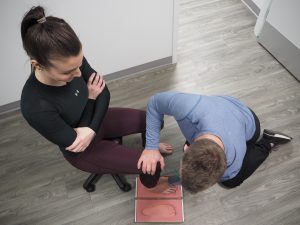Orthotics

Some common foot conditions in which the application of Custom Foot Orthotics is beneficial are listed below:
PES PLANUS; aka FLAT FEET, the PRONATED FOOT:
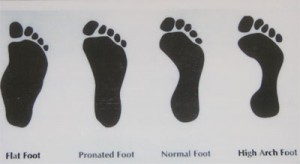
- Turning out of the heel bone away from the centre of the body
- Inward rotation of the leg
- Bulging of the inner aspect of the ankle
- Shifting of the forefoot outward from the heel
Heel pain, plantar fascitis, and bone spurs
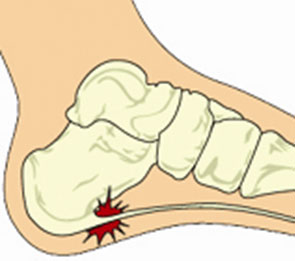
Bunions (Hallux Valgus):
Bunions, or Hallux Valgus is a common deformity of the big toe joint, a bunion occurs mostly in people who have flat feet or who wear tight fitting footwear that are too small for their dynamic foot size.
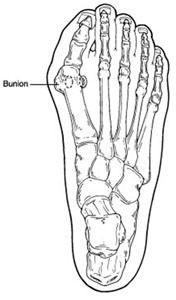
Women are more frequently affected with bunions because of tight, pointed, confining or high heeled shoes. Wearing high heels is especially stressful on the joints of the foot because all of the body’s weight rests on the ball of the foot; the foot is then forced into a narrow, pointed toe box, compounding the problem.
Older people are also vulnerable to bunions because of the higher incidence of arthritis affecting the big toe joint.
A bunion is a protuberance of bone or tissue around the joint. The enlargement occurs either at the base of the great toe or on the outside of the foot, at the base of the little toe. This is called a “bunionette” or “tailor’s bunion.”
The orthotic management of bunions is a Custom Foot Orthotic to help maintain proper foot alignment and function. This forces the toes to be evenly placed on the ground during standing, walking and running. This even placement will prevent the over use or misalignment of the first toe and prevent excessive forces acting on it’s joints and displacing the bones. The Custom Foot Orthotic will also support the arch of the flat foot preventing it from overpronating and reducing added forces on the big toe joint.
Modifications to the orthotic will also aid in bunion treatment, and include: 1st metatarsal cut outs, 1st ray cut-outs, reverse Morton’s extensions and kinetic wedges. All have been shown to reduce the progressive of the bunion.
PES PLANUS; aka FLAT FEET, the PRONATED FOOT:
Because diabetes is a systemic disease affecting many different parts of the body, ideal case management requires a team approach. The Podiatrist Physician, Pedorthist, Chiropodist, Chiropractor and Allied Health Professional are an integral part of the treatment team and work effectively in the prevention of amputations.
The key to amputation prevention in diabetic patients is early recognition and regular foot screenings, from a Podiatric Physician.
In addition to these checkups, there are warning signs that you should be aware of so that they may be identified and called to the attention of the family physician or podiatrist. They include:
- Skin color changes.
- Elevation in skin temperature.
- Swelling of the foot or ankle.
- Pain in the legs.
- Open sores on the feet that are slow to heal.
- Ingrown and fungal toenails.
- Bleeding corns and calluses.
- Dry cracks in the skin, especially around the heel.
Wound Healing:
Ulceration is a common occurrence with the diabetic foot, and should be carefully treated and monitored by a Podiatrist to avoid amputations.
Poorly fitted shoes, or something as trivial as a stocking seam, can create a wound that may not be felt by someone whose skin sensation is diminished due to neuropathy. Left unattended, such ulcers can quickly become infected and lead to more serious consequences.
Your Podiatric Physician knows how to treat and prevent these wounds and can be an important factor in keeping your feet healthy and strong. New to the science of wound healing are remarkable products that have the appearance and handling characteristics of human skin. These living, skin-like products are applied to wounds that are properly prepared by the Podiatric Physician. Clinical trials have shown impressive success rates.
If You Have Diabetes Already . . . DO:
Wash feet daily
Using mild soap and lukewarm water wash your feet in the mornings or before bed each evening. Dry carefully with a soft towel, especially between the toes, and dust your feet with talcum powder to wick away moisture. If the skin is dry, use a good moisturizing cream daily, but avoid getting it between the toes.
Inspect feet and toes daily
Check your feet every day for cuts, bruises, sores or changes to the toenails, such as thickening or discoloration. If age or other factors hamper self-inspection, ask someone to help you, or use a mirror.
Lose weight
People with diabetes are commonly overweight, which nearly doubles the risk of complications.
Wear thick, soft socks
Socks made of an acrylic blend are well suited, but avoid mended socks or those with seams, which could rub to cause blisters or other skin injuries.
Stop Smoking
Tobacco can contribute to circulatory problems, which can be especially troublesome in patients with diabetes.
Cut toenails straight across
Never cut into the corners, or taper, which could trigger an ingrown toenail. Use an emery board to gently file away sharp corners or snags. If your nails are hard to trim, ask your podiatrist for assistance.
Exercise
As a means to keep weight down and improve circulation, walking is one of the best all-around exercises for the diabetic patient. Walking is also an excellent conditioner for your feet. Be sure to wear appropriate athletic shoes when exercising. Ask your podiatric physician what’s best for you.
See your podiatric physician
Regular checkups by your podiatric physician are the best way to ensure that your feet remain healthy.
Be properly measured and fitted every time you buy new shoes
Shoes are of supreme importance to diabetes sufferers because poorly fitted shoes are involved in as many as half of the problems that lead to amputations. Because foot size and shape may change over time, everyone should have their feet measured by an experienced shoe fitter whenever they buy a new pair of shoes.
New shoes should be comfortable at the time they’re purchased and should not require a “break-in” period, though it’s a good idea to wear them for short periods of time at first. Shoes should have leather or canvas uppers, fit both the length and width of the foot, leave room for toes to wiggle freely, and be cushioned and sturdy.
Don’t go barefoot
Not even in your own home. Barefoot walking outside is particularly dangerous because of the possibility of cuts, falls and infection. When at home, wear slippers. Never go barefoot.
Don’t wear high heels, sandals, or shoes with pointed toes
These types of footwear can put undue pressure on parts of the foot and contribute to bone and joint disorders, as well as diabetic ulcers. In addition, open-toed shoes and sandals with straps between the first two toes should also be avoided.
Don’t drink in excess
Alcohol can contribute to neuropathy (nerve damage) which is one of the consequences of diabetes. Drinking can speed up the damage associated with the disease, deaden more nerves and increase the possibility of overlooking a seemingly minor cut or injury.
Don’t wear anything that is too tight around the legs
Panty hose, panty girdles, thigh-highs or knee-highs can constrict circulation to your legs and feet. So can men’s dress socks if the elastic is too tight.
Never try to remove calluses, corns or warts by yourself
Commercial, over-the-counter preparations that remove warts or corns should be avoided because they can burn the skin and cause irreplaceable damage to the foot of a diabetic sufferer. Never try to cut calluses with a razor blade or any other instrument because the risk of cutting yourself is too high, and such wounds can often lead to more serious ulcers and lacerations. See your podiatric physician for assistance in these cases.
Your podiatrist physician/surgeon has undergone extensive training in the diagnosis and treatment of all manners of foot conditions. This training encompasses all of the intricately-related systems and structures of the foot and lower leg including neurological, circulatory, skin and the musculoskeletal system, which includes bones, joints, ligaments, tendons, muscles and nerves.
– Information courtesy of The American Podiatric Medical Association –
Orthotic Management:
The application of a soft or accommodative Custom Foot Orthotic constructed from a non-corrected positive of your foot will aid in maintaining healthy feet.
The fabricated orthotic device will decrease shear forces acting on the tissue of your feet while dispersing ground reaction and gravitation forces on your feet.
The special material in our Diabetic Orthotic allows the device to be soft and flexible while maintaining its shape over time and not breaking down like several other non-custom diabetic Orthotics.
Achilles Tendonitis
Achilles Tendonitis is characterized by inflammation of the sheath surrounding the Achilles tendon.
The presence of pain behind the heel, ankle and lower calf are key signs of this condition.
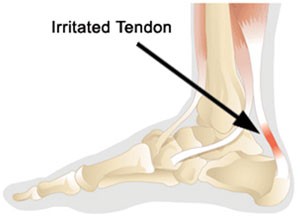
The condition arises from the counter rotational forces acting on the tibia against the femur as a result of excessive pronation of flat feet which causes the heads of the tendon to torque against one another and over stretch the tendon.
A Custom Foot Orthotic helps maintain function and alignment of the heel and prevent over pronation of the foot.
The use of a rear foot post to stabilize the orthotic device inside your footwear will lift the heel about 3mm or 1/8 inch, which will allow the Achilles tendon to be lax and not stretched while in its resting state. The application of the heel lift is usually only temporary, for about 6-8 weeks until further consultation by your foot specialist’s follow-up assessment. However, patients who suffer Achilles tendonitis do well with a permanent dual density heel cup added to the orthotic.
Metatarsalgia
Metatarsalgia is a general term used to describe a painful foot condition in the metatarsal region of the foot – the area just before the toes, more commonly referred to as “the ball-of-the-foot”.
This is a common foot disorder that can affect the bones and joints at the ball-of-the-foot.
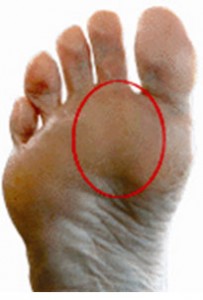
Improper fitting footwear is the cause of the pain. Footwear designed with a high, wide toe box (toe area) and a rocker sole is ideal for treating metatarsalgia. The high, wide toe box allows the foot to spread out while the rocker sole reduces stress on the ball-of-the-foot.
Custom Foot Orthotics designed to relieve ball-of-foot pain usually feature a metatarsal pad.
The Custom Foot Orthotic is constructed with the pad placed behind the ball-of-the-foot to relieve pressure and redistribute weight from the painful area to more tolerant areas.
Custom Orthotics in Mississauga
